10 Things to Make With Plantain Herb
Learn how to turn plantain, a common backyard weed, into ten useful and healing products, including lip balm, lotion bars, tincture, and more!
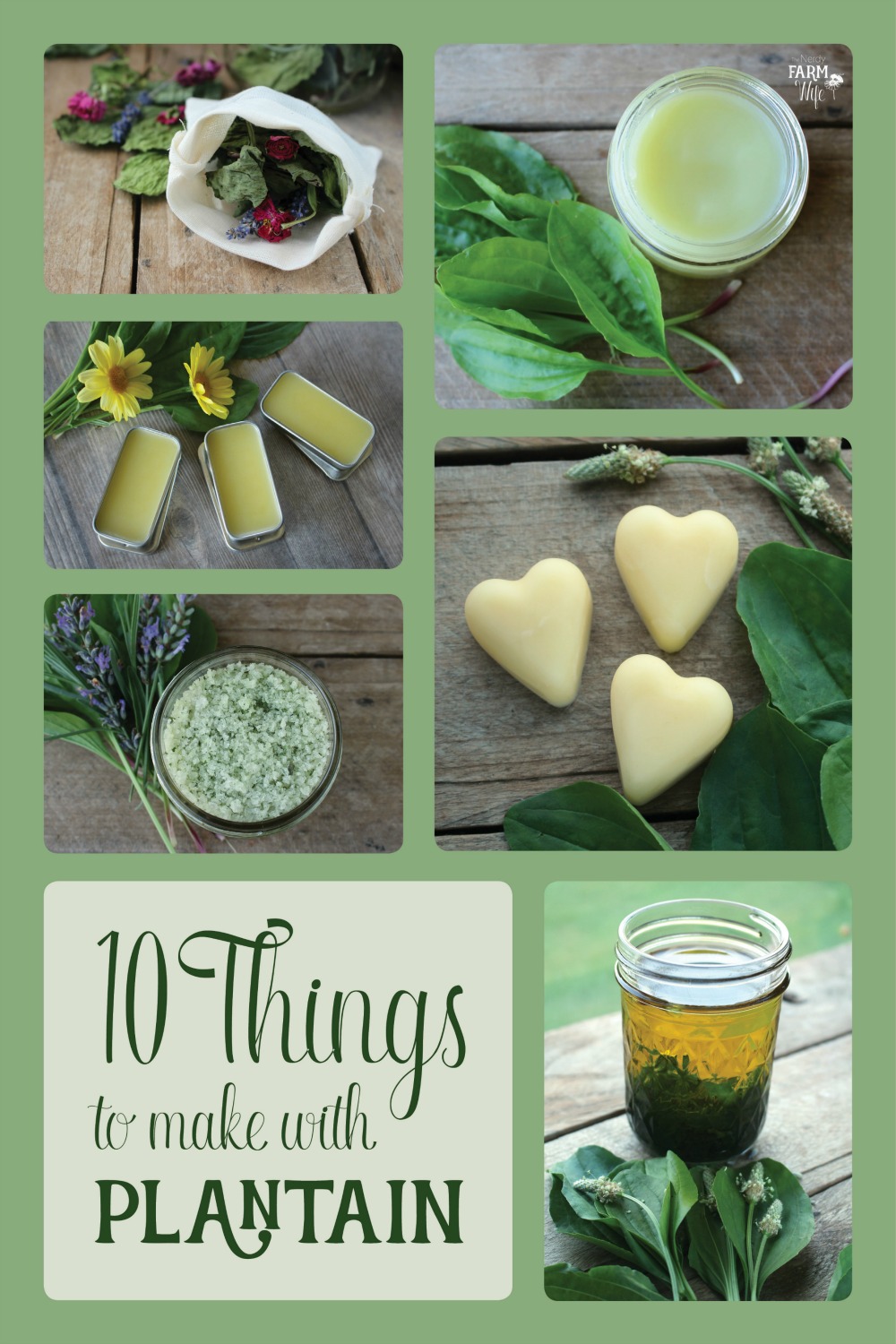
Plantain (Plantago major, Plantago lanceolata) is a common leafy green weed found all over the world. If you have a yard or have visited a park before, you’ve likely spotted or stepped on a plantain plant!
Like most things deemed as “weeds”, plantain offers an array of good-for-you benefits.
According to Richo Cech, author of my well-loved and often-used copy of Making Plant Medicine, plantain is specific for treating skin problems such as acne or eczema.
It’s also antiseptic and astringent and is the ultimate plant to grab for a good old-fashioned in-the-field poultice. (More on that below!)
If you’ve never foraged plantain before and need help identifying it, be sure to read through my comprehensive article on Foraging Plantain Leaf & Uses, which is located over at my family’s website (Unruly Gardening).
Before you begin:
1. Some of these recipes call for drying plantain first. To dry flowers and herbs, I usually just spread them out in single layers on paper towels or clean dish towels and let them air dry for several days. You could also us a dehydrator set to very low heat for a few hours.
3. There are a few affiliate links scattered in this post. That means if you click on one and make a purchase, I earn a small commission for sending a customer their way. This costs you nothing extra. Thank you! :)

1. Plantain Infused Oil
Plantain infused oil is a handy staple to keep around for making skin soothing salves, lotions, creams, soaps and such. It’s also excellent for using on dogs, cats and other such critters to treat hot spots, flea bites, scrapes and minor skin irritations.
Shelf life of the strained, infused oil is around 9 months to a year.
To make it, fill a canning jar about half-way up with crumbled dried plantain leaves. Cover with about twice as much as your favorite carrier oil, or to the top of the jar. (Some oils I like to use include sunflower, olive and sweet almond.)
For a quick infusion, or if infusing coconut oil: Set the uncovered jar down into a small saucepan filled with a few inches of water. Heat over a low burner for a few hours, keeping a close eye that the water doesn’t evaporate out. Remove from heat and strain.
For a slower, more traditional infusion: Cap the jar of crumbled dried leaves and oil and tuck away in a cabinet for around 4 to 6 weeks, shaking occasionally as you remember to. When the infusing time has passed, strain.
For a third option: You could also place the jar of crumbled dried leaves and oil in a sunny windowsill for several days to a week to jump start the infusion. (Don’t store for long periods in sunlight though, as it tends to fade flowers and herbs over time.)

2. Coconut Plantain Balm
Newsletter readers will recognize this balm as the subscriber’s bonus recipe included in May’s issue.
Click HERE to access the printable pdf file containing the complete recipe and instructions to make.
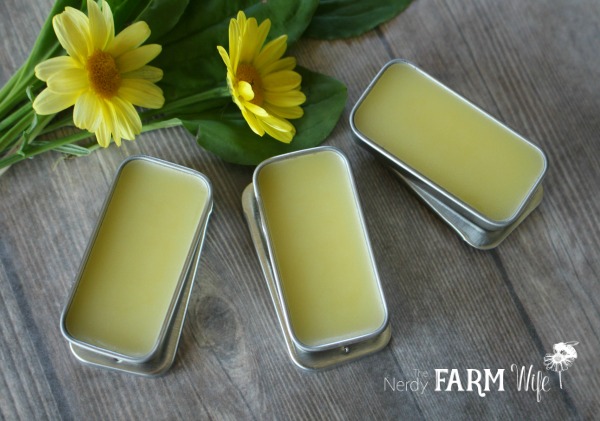
3. Plantain Lip Repair
Got dry chapped lips that just won’t seem to heal? Give plantain a try!
To make this, you’ll need:
- 2 oz (57 g) plantain infused olive or sunflower oil
- 0.5 oz (14 g) castor oil (or more olive/sunflower oil)
- 0.5 oz (14 g) shea, mango, cocoa or kokum butter
- 0.5 oz (14 g) beeswax
- 10 to 12 lip balm slider tins
Melt the oils, butter and beeswax together in a double boiler (or a makeshift double boiler made out of a canning jar and a saucepan containing a few inches of water. Pour into slider or small half-ounce tins.
For more on making and creating lip balm recipes, check out my article on How to Make Your Own Lip Balm.
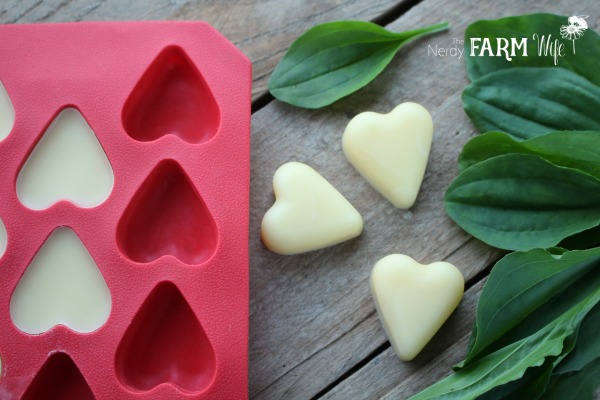
4. Plantain Lotion Bars
Lotion bars are so fun and easy to make. They’re the perfect thing for those tough to treat dry spots like calloused heels and hands.
I usually make lotion bars with equal parts of oil, butter and beeswax measured by volume, but have also included the corresponding weights in grams, for those who prefer to use a scale.
To make, combine 1/4 cup (52 g) plantain infused oil, 1/4 cup (28 g) beeswax and 1/4 cup (44 g) shea, mango or cocoa butter in a heatproof canning jar or upcycled tin can. (For a vegan version, use roughly half as much candelilla wax instead of beeswax.) Set the jar/can down into a saucepan containing an inch or two of water. Place the pan over a medium-low burner and heat until everything is melted. If you’d like, you can add a few drops of essential oil before pouring into heatproof silicone molds. I bought the mold shown at a local store a few Valentine’s Days ago. It was intended for making chocolates, but makes tiny lotion bars that are perfect for single uses. Feel free to use any flexible heat-proof mold that you’d like though!
To use, rub a lotion bar over your skin wherever it feels dry. They’re especially helpful for spot treating rough feet, knees and elbows. Store your lotion bars in a cool area, out of direct sunlight and they should have a shelf life of around 9 months to a year.

5. Lavender Plantain Bath Salts
I absolutely love these bath salts! Besides being easy to make, they have a wonderful natural scent that tends to stick around a while as long as you keep them stored properly. They’re also a great way to use up lavender leaves once the flowers have faded away.
To make, blend 3/4 cup Epsom salt and 1/4 cup roughly chopped fresh plantain leaves mixed with fresh lavender leaves (and/or flowers) in a mini food processor, like THIS ONE.
Spread the now-green salts in a single layer on wax paper and allow to air dry for a day or two. Once completely dry, store in a tightly closed glass jar.
To use, pour the bath salts into a cotton muslin bag or an old clean sock. Tie up tightly and toss in the tub as it fills with warm water. Shelf life is at least 6 to 9 months.
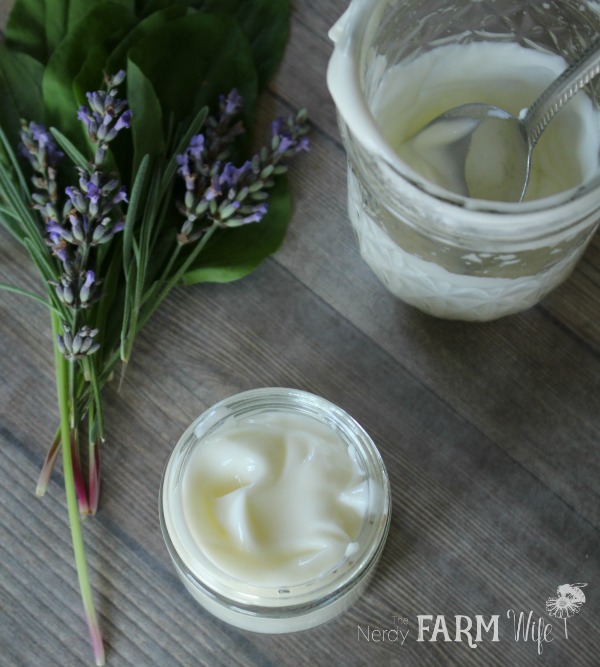
6. Lavender Plantain Lotion
This lovely lotion is an excellent choice for soothing dry, itchy or flaky skin. It can be used as a lightweight daily moisturizer as well.
If giving as a gift, it couples nicely with Lavender Plantain Bath Salts (see recipe above).
To make this, you can find the full recipe HERE.

7. Herbal Plantain Bath Bags
Bath bags are insanely easy to create and put together.
To make, start with a few of your favorite dried herbs. For the one shown, I chose dried rose petals, lavender and plantain leaves.
Crumble them up slightly and stuff in a cotton muslin bag or an old clean sock.
You may also decide to include other ingredients such as Epsom salt (helps sore muscles), sea salt (contains natural minerals) and oatmeal (soothes skin irritation and itchiness) to enrich your bath further.
Once the bag is filled, tie tightly and drop in warm running water as it fills your tub.
Take a bath as usual and enjoy!

8. Plantain Infused Vinegar
Plantain-infused vinegar makes a great hair rinse for itchy, flaky scalps or a spot treatment for pesky bug and chigger bites.
To make the vinegar:
Go out and pick some fresh plantain from unsprayed areas. Fill a canning jar about half full of fresh leaves. Pour apple cider vinegar over them and cap with a non-metallic lid. Vinegar will corrode metal, so if that’s the only type of cap you have, use a layer of plastic wrap between it and the vinegar. Let this sit for a week or two in a cool, dark place. Strain the vinegar and store for a year, possibly longer, in a glass container out of direct sunlight.
To use as a hair rinse:
Dilute the infused vinegar with an equal part of water. (So, if you have 1/2 cup vinegar, use 1/2 cup water). Mix well and pour over hair after shampooing to help relieve itchy flaky scalp.
To use as a spot treatment for pesky bugs and chigger bites:
Dilute the infused vinegar with an equal part of witch hazel. Dab on bug and chigger bites as needed.
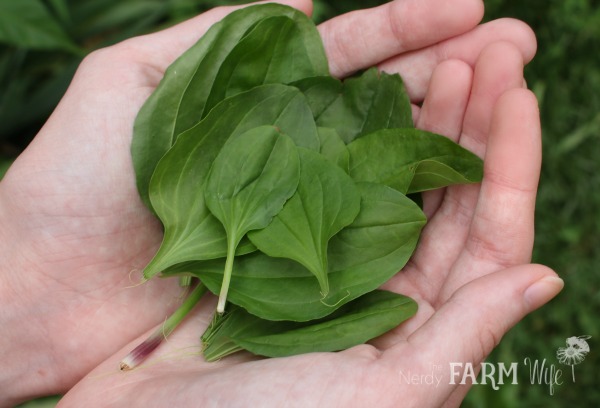
9. Plantain Poultice
If you spend time outdoors, you’re bound to get an occasional bee sting, bug bite, splinter in the finger or other such minor ailment.
One of the handiest ways to treat these skin irritations is with a “spit poultice.” Basically, all you need to do is find a beneficial leaf or flower, chew it up a bit, then spit it out and place on your injured area for a while or until it starts to feel better. If you have a splinter or thorn that you can’t see, but can feel – place a spit poultice on the spot, hold it in place with your fingers, a strip of cloth, or even a sock for a while and it will pull the irritant right to the surface of your skin where it can easily be scraped out.
It may sound gross to some of you (I felt the same way in the past!), but this is a highly effective method that delivers real results! You can also smash the leaves with a mortar and pestle, or use your fingers to mash and bruise them.

10. Plantain Tincture
Plantain tincture can be dabbed directly on acne spots.
To make, combine 1 part fresh leaves with 2 parts vodka. So, if you have 1/2 cup of fresh plantain leaves, pour 1 cup of vodka over them. (If using dried plantain, use less – more like 1 part dried leaves to 4 parts vodka.)
Combine in a canning jar, cap, shake and store in a cool dark place for four to six weeks before straining. Shelf life of most tinctures is at least one year, but will probably stay useful much longer than that. Store out of direct sunlight and high heat.


Timing is everything. Tonight I’m going to make some plantain lotion and a few bars for my psoriasis. The plantain leaves look like what our country yards was overgrown with, but they never produced the stems and flowers that were in the photograph. My rabbits loved them, but I don’t know if they were plantain or not. In Florida, there must not be one plantain in the entire state, so I get mine from Mountain Rose. Now that I know you get a slight fee, I will use your name.
Have you ever done anything with Comfrey? I know it cannot be ingested, but the claim that it can repair broken bones has me rather doubtful.
That’s great about the perfect timing! Thank you for using my name as well, at Mt Rose Herbs. :) I love using comfrey in combination with arnica, for salves and creams specifically for arthritis and bruising. I’ve heard too that it mends broken bones, but haven’t personally tried it.
Once, I found an injured baby turkey that had fallen a great distance from its nest and was in poor shape. I used a tea of plantain, comfrey & nettle externally (and internally, since livestock usually enjoys comfrey as a nutritious treat) and it was amazing how visibly it helped his injuries. Hopefully, I’ll never have need to personally experiment, but if I ever break something, I would test comfrey on myself as soon as feasible.
Jan hi, I have been using comfrey root poultices on shin splints, knee and hip replacements, as well as spinal injuries, like herniated disks, all summer long. I have also been using comfrey leaf compresses with arthritis. It really is decreasing the recovery time in all cases. Something must be working to repair the tissues. Michael Tierra has said that it does regenerate cells and enhances cellular growth. I love your plantain blog. It is great for children! Thank you
Hi Alexis, So glad that you’re finding success with the comfrey root poultices! I hope you continue to keep feeling better!
Good morning, excellent post-I shared it thank you
Kathy
Thank you Kathy! I appreciate that! :)
How can I use it on my dog??
Hi Teresa! I use a plain plantain salve (no essential oils) for dog hot spots or minor first aid purposes.
You can also make a tea with plantain and use the comfortably cooled tea to rinse itchy pups after their bath. (Pour the tea over them last, then let it air dry on them, don’t rinse it off.)
Hi,
I had a good laugh. Here in the caribbean ,plantain is the name of the big green bananas that you cook. I was looking at the recipes with great interest. Finally something that grow around here….wrong plantain.
Bye isabella
Hi Isabella! Sorry for the mixup! :) I’m afraid I don’t have any recipes for plantain fruit handy, though I did experiment with them some when my son was younger and allergic to many foods. What kinds of plants do grow around you that you’d like to use? I’d love to know!
I used a plantain poultice to pull the infection out of an infected incision I had from a total knee replacement. I had already been through four rounds of Bactrim. After four months, my incision refused to heal. I remembered that when I was a kid, anytime one of us had an infected splinter or infected scrape, my Dad would make a plantain poultice, put it on before bed, and by the next morning, the poultice would draw out the splinter or the infection. I decided to try that instead of another round of anti biotics….and just like magic, it pulled all of the pus out and my knee healed.
Hi Mary, What a great memory of your dad! It’s wonderful to hear how the plantain helped heal your knee right up! :)
We keep plantain tincture in a spray bottle and spray directly on bug bites, scrapes, rashes, bruises, cuts, even the dog when she has an itchy spot! It makes me feel a little like the dad in “My Big Fat Greek Wedding” but it really is good for so many things…
Hi Kate! That sounds like a great idea! Thanks for sharing!
I scalded my arm blanching broccoli this summer. I was thinking as I had my arm, elbow to wrist, under the cool water for 15 minutes, this is a good time to test 2 different burn treatments. I rubbed plantain leaves on 1/2 and aloe vera on the other 1/2.
Results: plantain no redness or pain, aloe very red and tender! A month later can still see redness on the aloe 1/2 ?
Hi Nancy, I’m so sorry about your arm – that sounds like it was a painful experience! Thank you for sharing your test results with us! Did you use fresh aloe or a bottled aloe? I remember as a kid my mom bought a green colored kind from the store and it made my skin very irritated, while fresh aloe didn’t. It’s very interesting – thank you for sharing!
what can you do with Plantian seeds?
Hi Kathy! I haven’t experimented with the seeds, but Susun Weed says:
“All wild seeds are rich in omega-3 fatty acids. Instead of adding flax seed to my diet to boost essential fatty acids, I use plantain seeds! (And nettle seeds, yellow dock seeds, grass seeds, amaranth seeds, and lamb’s quarter seed.)”
http://www.susunweed.com/herbal_ezine/October08/wisewoman.htm
So it sounds like they’re useful and helpful as well! :)
In France I saw little bags of it at the organic store. You put them in a glass of water and stir. Let set. It will create a kind of gel that is said to be able to clean your gut, as stated in the packaging. I haven’t tried though…
I wonder if the green seeds (not yet dried on the stalk) can also be used in the same fashion…
Are there sites you’d recommend to purchase a silicone mold for lotion bars?
Hi Erica! Two that I like are BrambleBerry.com and Amazon.com. You can also check local craft stores or the baking/holiday section of your local grocery or big box store.
Wondering what you use the plantain tincture for
Hi Tonya! Plantain tincture can be dabbed on acnes spots or bug bites. You can dilute it in some water and use it as a rinse for itchy scalp as well. (Make sure it doesn’t get in your eyes as it will probably sting!) :)
This has renewed my interest in creating my own herbal treats ! Having got tied up in the work/home life spiral, all my interest were put aside – NO MORE !!! I just strained my Plantain infused oil so Let the making comense !!!!
Hi Michelle, I’m so glad that you found the article inspiring! Happy herbal crafting! :)
Very informative. I wonder what the Filipino term is for plantain( I thought it was a kind of banana). I am interested to prepare this lotion for eczema.
Hi Maria! It agree that it’s really confusing that the fruit and the leafy weed share the same name! :) I hope that you enjoy the lotion recipe if you try it out!
Im wondering my niece has allergic reactions to many foods she breaks out in hives quite frequently. I’m wondering if something with plantain would help her.
Hi Lisa! It’s hard to know for sure, but it might be helpful if she’s not allergic to plantain! I’m so sorry to hear she has so many allergies. My older brother & I practically drank Benadryl with every meal when we were kids, so I can relate to how miserable chronic hives and allergies can be! I hope that she’s able to find some relief from her allergies as she grows older!
this is great information, thank you for your help!
Can you infuse witch hazel with plantain? Would you use dry or fresh leaves? Cold or heated witch hazel?
Hi Jenny! Yes, you sure can infuse witch hazel with plantain. I actually like to infuse plantain in a combination of witch hazel and apple cider vinegar (along with rose petals and yarrow) as a remedy for bug bites & chiggers.
It works wonderfully!
Fresh or dry works, but I would use cold witch hazel so as not to evaporate off the alcohol.
Can you provide the instructions for the plantain, vinegar, witch hazel? I thought I read something about witch hazel and vinegar as a good mix and it was called something but can’t find the article now.
Hi Cyndie! I combine vinegar and witch hazel in this recipe:
https://thenerdyfarmwife.com/rose-plantain-yarrow-itch-remedy/
It has plantain, but also rose and yarrow in it – however, you can leave out the rose and yarrow and just make a plantain/vinegar/witch hazel mixture. :)
can I use sea plantain for these recipes? thank you so much.
Hi Cheryl! That’s a great question! I’m not familiar with sea plantain, so I’m not 100% sure.
I would do some research on it, and if it’s in the plantago family and is considered edible, there’s a good chance it’s useful.
What I do when I want to know more about an unfamiliar plant is to google it, find its latin name, then do some searches on it like:
sea plantain pubmed (this will give you any scientific studies) (and I would use the latin name instead of “sea plantain”)
or
sea plantain herbal uses
or
sea plantain salve
and
so forth and see if anyone has suggestions for that plant to explore further.
I have just ‘discovered” plantain herbs…literally in the past hour I discovered 3 varietis ( major , rugels and lance in my front yard…did some basic reading online …saw ome remarkable claims… okay I’ll try this. I picked five leaves(3 broadleaf / 2 Rubelli) brought them in washed,dried and bruised them . Experiment 1- simply rubbed the leavesfor 20-30 seconds across my recently acquired itching ankles (from walking in my yard,)…itch gone! Experiment 2 used the same 5 leave on my mpet painful finger knuckle ( chronic oesteo -arthritis) .wrapped it around my finger ,held tight for a minute or so…so much less pain and more range of movement! I so look forward to using and exploring my new discovery. They are abundant, free and better and faster than the current salves and gels that i use daily. Also can’t wait to discuss with my dear friend and primary physician. To my Cherokee friends…I have no doubt you already knew this.
Hi Bill, Thanks for sharing your good results with plantain! It really is an excellent and freely available herb. :)
Plantago is the other name for the plant…for clarity’s sake!